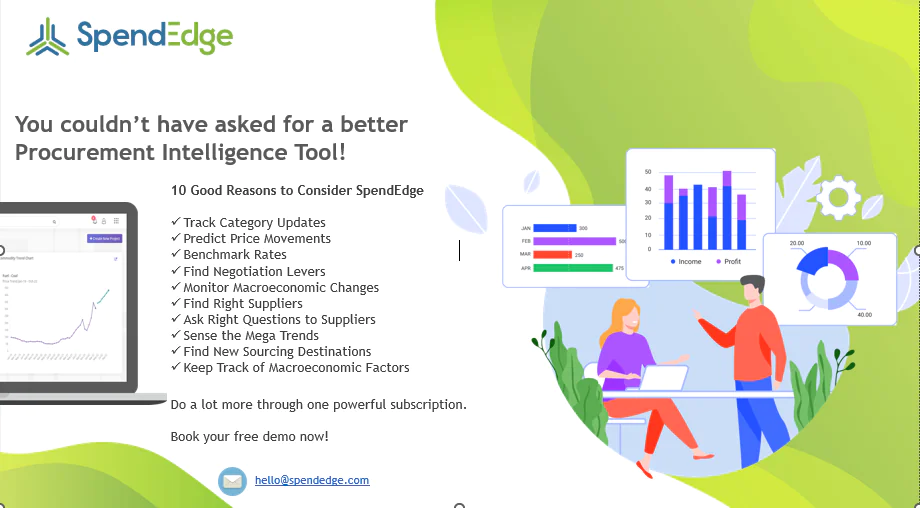Key Takeaways
- Strategic sourcing solutions empower companies to make informed “make-or-buy” decisions, maximizing value and achieving a competitive edge.
- Cost-benefit analysis is crucial, but a holistic view encompassing total transaction costs is essential.
- Strategic factors like core competencies and intellectual property can outweigh short-term cost savings.
- Collaboration between departments like procurement, engineering, and finance is vital.
- Continuous evaluation is necessary due to evolving technologies, global markets, and changing business needs.
In manufacturing, every product is a culmination of numerous processes, from initial design to final assembly. A critical decision within supply chain management, manufacturers constantly face is the allocation of these processes: should they be completed in-house (“make”) or entrusted to an external supplier (“buy”)? SpendEdge delves into the complexities of this “make-or-buy” dilemma, exploring the role of cost analysis, strategic considerations, and ultimately, optimizing production for a competitive advantage.
The “Make” vs “Buy” Conundrum
Every manufactured product entails a series of processes, from design and engineering to assembly. Manufacturers face a fundamental question: should they produce each component in-house (“make”) or outsource it to an external supplier (“buy”)? This seemingly straightforward decision hinges on a complex interplay of factors encompassing cost, risk, expertise, and strategic objectives.
Cost-Benefit Analysis: The Foundation
The cornerstone of any “make-or-buy” decision is a thorough cost-benefit analysis. This involves meticulously assessing the total transaction costs associated with each option. In-house production factors include:
- Labor costs: Salaries, benefits, and training expenses for the required workforce.
- Overhead costs: Factory space, utilities, and maintenance costs.
- Production costs: Raw materials, machinery, and energy consumption.
- Capital investment: Costs of acquiring and maintaining production equipment.
On the other hand, buying from an external supplier introduces additional considerations:
- Purchase price: The cost of the component from the supplier.
- Shipping and transportation costs: Logistics expenses associated with receiving the component.
- Transaction costs: Costs associated with managing the supplier relationship, including quality control procedures.
Beyond the Numbers: Strategic Considerations
While cost analysis forms the bedrock of decision-making, strategic risk mitigation factors play an equally crucial role in strategy support.
- Expertise: Does the company possess the necessary in-house expertise for efficient production? Conversely, can a qualified external supplier offer superior knowledge or technology?
- Quality control: Maintaining consistent quality is paramount. Does the company have robust quality control processes in-house, or can a reliable supplier guarantee it?
- Flexibility: Can the in-house production accommodate fluctuations in demand? Can an external supplier adapt to changing production requirements?
- Capital investment: Does the company have the financial resources for upfront capital investment in machinery? Outsourcing can free up capital for other strategic initiatives.
- Risk management: “Make” exposes the company to risks like equipment breakdowns and labor disruptions. Outsourcing mitigates some of these risks but introduces dependence on the external supplier.
Triggers for Re-evaluation
The optimal “make-or-buy” decision is not static. Several triggers necessitate reassessment:
- Quality problems: Consistent quality issues with in-house production might necessitate outsourcing for better control.
- New product development: Foraying into new products might require specialized expertise that can be most effectively accessed through external suppliers.
- Market downturn: A decline in demand may incentivize outsourcing components to reduce fixed costs associated with in-house production.
Beyond Cost Accounting: A Holistic Approach
Traditional cost accounting methods often focus solely on direct costs like labor and materials. Strategic sourcing solutions require a broader perspective encompassing the full spectrum of total transaction costs. These include:
- Transaction costs: Costs associated with managing the supplier relationship, including communication, negotiation, and quality control procedures.
- Inventory holding costs: Costs associated with storing and managing raw materials and finished goods.
- Lead times: The time it takes to receive components from an external supplier can impact production schedules.
Strategic Factors Trumping Cost Savings
While cost minimization is a vital objective, there are situations where strategic factors outweigh short-term cost savings. For instance, a company may choose to “make” a core component, even at a higher cost, to retain intellectual property, maintain control over quality, or foster a competitive advantage through unique design features.
The Evolving Sourcing Landscape
The landscape of “make-or-buy” decisions is constantly evolving. Technological advancements can alter the cost-effectiveness of in-house production. The rise of automation and 3D printing can disrupt established manufacturing processes. Furthermore, the globalized economy offers access to a vast pool of potential external suppliers with varying capabilities and cost structures.
Strategic Sourcing: A Collaborative Endeavor
Effective “make-or-buy” decisions require a collaborative effort between various departments within an organization. Procurement managers assess supplier capabilities and negotiate pricing. Engineering teams evaluate technical feasibility and quality standards. Finance provides financial modeling and cost analysis. Ultimately, senior management makes the final call based on a comprehensive understanding of the internal and external environment.
Conclusion
In conclusion, the “make-or-buy” decision in manufacturing is a complex and multifaceted process that requires a strategic approach. While cost-benefit analysis forms the foundation of this decision-making, it is imperative to consider total transaction costs and other strategic factors such as core competencies, intellectual property, and risk management. A holistic view that integrates input from procurement, engineering, and finance departments ensures a balanced approach, leveraging internal expertise and external supplier capabilities. Continuous evaluation of these decisions is crucial in adapting to technological advancements, market fluctuations, and evolving business needs. Ultimately, a well-informed “make-or-buy” strategy not only optimizes production but also enhances competitive advantage in a dynamic global market.





